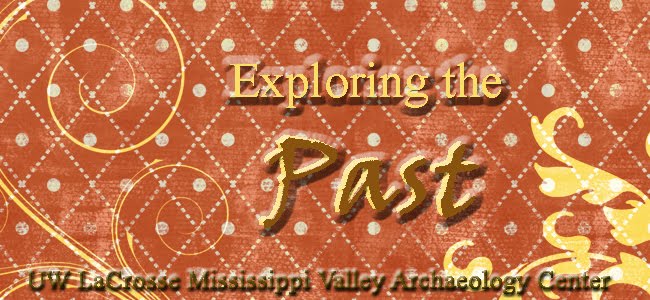Dr. Theler reviewed our trip to the Effigy Mounds National Monument and discussing Raisbeck Mounds which has 5 basic shapes: 38 conical, 14 linear, 13 bird shaped, 11 "canine" or bear shaped, and 3 oval. The Hopewell culture, which includes the burial ceremonies, commenced or lived in the Upper Mississippi River Valley in Western Wisconsin from A.D. 1000 to 200 during the Middle Woodland period. One to 6 humans were buried in some mounds, but the normal count was 1 to 3 individuals.
click here
Dr. Theler then discussed William Hurley's study and duplication of the Hopewell cordage, or knotting patterns, found in their fabric made of nettle. Nettle is the best fiber to use because it is extremely strong and wide spread. The Amish are still making nettle cords. Sometimes the cordage was imprinted on to wet vessels before they dried in order to make the surface rough and prevent slipping while holding them. Can you consistently make a square or granny knot? It's not as easy as you think. It's easy to make a cord, but the sophisticated technology needed to get a consistent cord is difficult. Anthropologists think mothers handed down their unique pattern to their daughters. This reminded me of the fishermen patterns unique to each family on their Irish sweaters.
A hypothesis that we typically use for our Science projects is one or two sentences. Dr. Theler's hypothesis on why the Woodland Indians disappeared is complicated, but I will attempt to simplify it. During AD 1048, there was a severe winter, the population had increased and depleted the resources because the bow and arrow made killing deer easier, and there was little fire wood on the prairie. They reorganized and moved further West to hunt bison in order to let the deer repopulate. Once you miss one generation, you forget the hunt cycle so they didn't return to this harsh winter environment.
After the Woodland Indians disappeared, the Cahokia Indians, who had a sophisticated village north of East St. Louis, Illinois, moved into the Upper Mississippi Valley. The Cahokia Monks Mound near East St. Louis includes a park and museum where you can learn more about their culture. http://cahokiamounds.org/learn/ They had a specialization of labor, elaborate rituals, spherical pottery, arrow heads with notched points, and the concept of land ownership. If the winters are harsh in the Upper Mississippi River Valley, why did some Cahokia move here to farm and hunt deer?

No comments:
Post a Comment